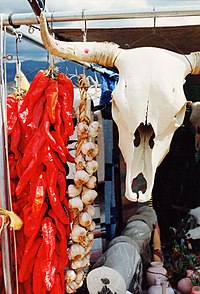Southwestern United States
From Wikipedia, the free encyclopedia.
|
the Southwest
|
||
|
|
The Southwestern United States or simply the Southwest is a region of the United States that is drier in weather than the adjoining Southern United States and Western United States; the population is less dense and, with moderate Mexican and American Indian components, more ethnically varied than neighboring areas. Outside the cities, the region is a land of open spaces, much of which is desert. The magnificent Grand Canyon is located in this region, as is Monument Valley. This region contains many Indian reservations including the Navajo, Apache, Hopi, Zuni and Pueblo people. Most of the Southwest once belonged to Spain or Mexico but ownership was ceded to the United States after the Mexican-American War of 1846-48, with the Gadsden Purchase of 1853 following. The Treaty of Guadalupe Hidalgo defines sovereignty over this region.
States forming the core of the southwestern region (red):
- Arizona (U.S. West)
- New Mexico (U.S. West)
States sometimes considered southwestern (pink):
- California (U.S. West)
- Colorado (U.S. West)
- Nevada (U.S. West)
- Oklahoma (U.S. South)
- Texas (U.S. South)
- Utah (U.S. West)

Texas is a part of the Southern United States, as it shared that region's view of States Rights, taxes and tariffs, and slavery; and membership in the Confederate States of America during the American Civil War. It is also unusual in having for a time been an independent nation, the Republic of Texas. The American Civil War dragged six months longer in Texas than in the rest of the nation, primarily in the southern tip of Texas, where Mexican gold coins had displaced the worthless Confederate dollar, and smugglers profited in the North-South trade with Mexico. During the Civil War, the only way to get Southern cotton through the Union blockade to its European markets was to sell it to a Mexican intermediary, who would then ship it on a neutral flagged Mexican vessel. Because of this the Union sought to gain control of the Rio Grande and a number of battles were fought in the area, including the very last battle of the Civil War, the Battle of Palmito Ranch.
Mexican heritage continues to exert a strong influence on the U.S. Southwest, which is a convenient place to settle for immigrants (legal or illegal) from farther south. The regional population is growing rapidly, with Arizona in particular rivaling the southern states as a destination for retired Americans in search of a warm climate.
Population growth in the hot, arid Southwest has depended on two human artifacts: the dam and the air conditioner. Dams on the Colorado and other rivers, and aqueducts such as those of the Central Arizona Project have made it possible to develop large areas of farmland with irrigation and have brought water to once-small towns such as Las Vegas, Nevada, Phoenix, Arizona, and Albuquerque, New Mexico, allowing them to become metropolises. Las Vegas is renowned as a world center for gambling, while Santa Fe, New Mexico, the historic center of government for much of the Southwest is famous as a center for the arts, especially painting, sculpture, and opera. Another system of dams and irrigation projects waters the California Central Valley, which is noted for producing large harvests of fruits and vegetables. The combined population of the eight Southwest states is around 70 million (2005).
See also
- Chihuahuan desert
- Great Basin desert
- Mojave desert
- Sonoran desert
- Tex-Mex cuisine
- Aztlán
- MEChA
- Voz de Aztlán
| Geographic regions of the United States |
|---|
| Central | Coastal States | Deep South | East | East Coast | Gulf Coast | Mid-Atlantic | Midwest Mountain States | New England | North | Northeast | Northwest | Pacific | South | South Atlantic South Central | Southeast | Southwest | Upper Midwest | West | West Coast |
| Multinational regions: Border States | Great Lakes | Great Plains | Pacific Northwest |


